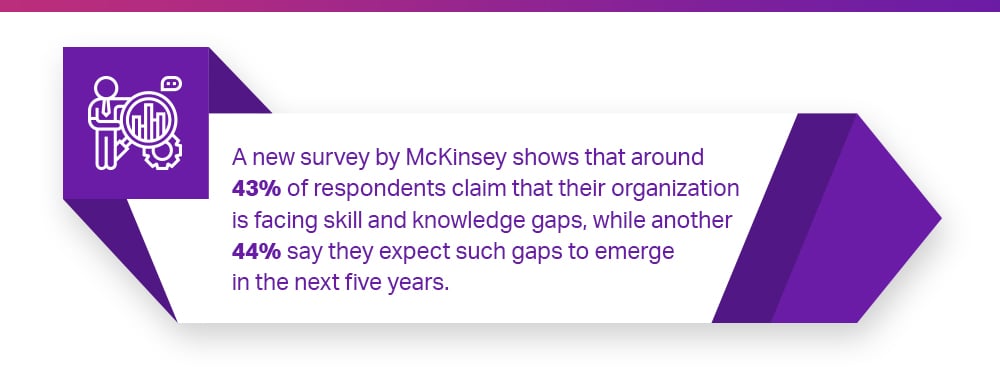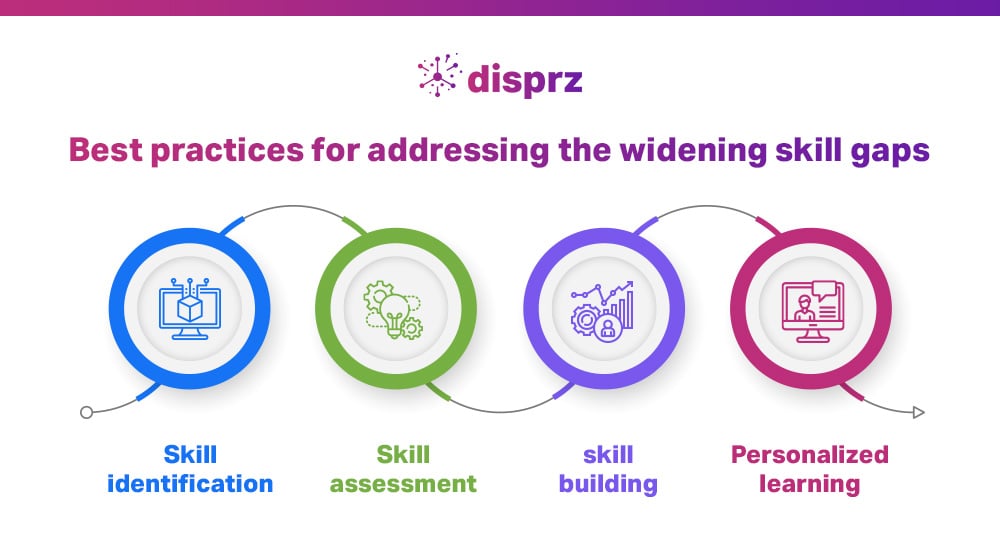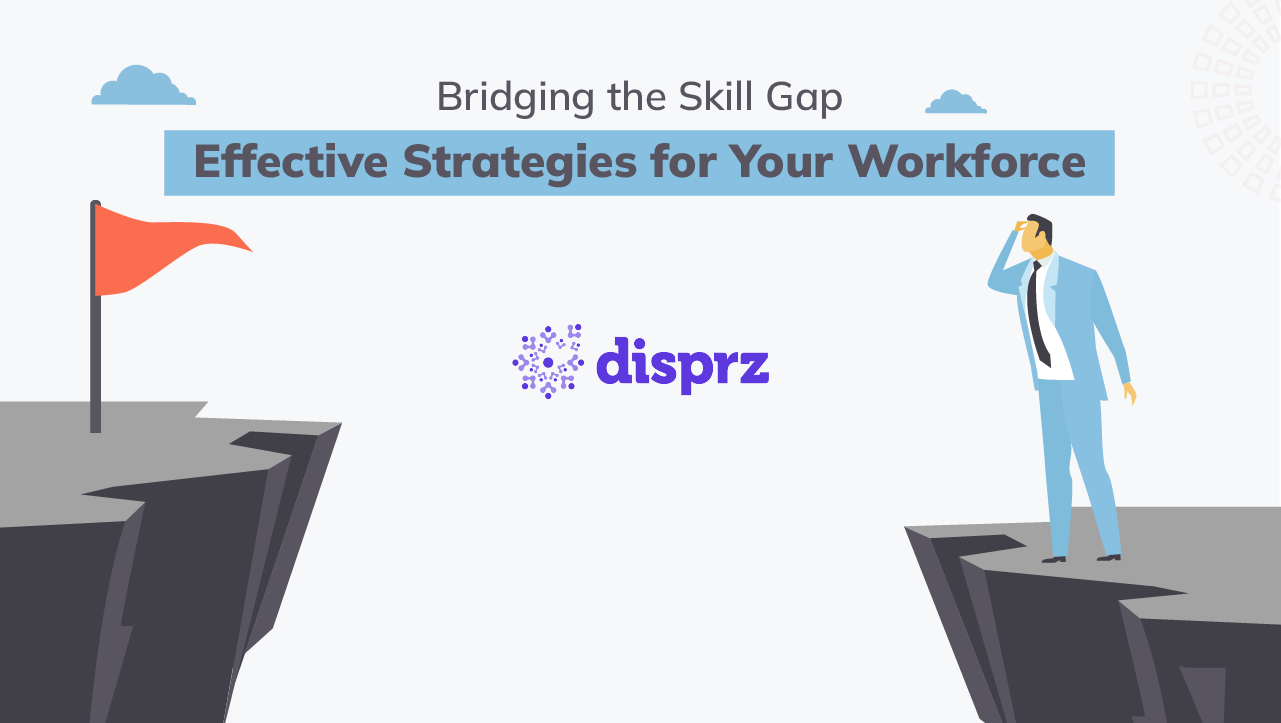As businesses rapidly embrace new models and strategies to include updated technology and changing customer needs, many organizations are witnessing knowledge gaps. These gaps are expanding, as many employees are now required to do jobs that they weren’t hired or trained to do.

The above data shows the importance of bridging knowledge gaps and highlights that few organizations are prepared to do so. Addressing these gaps is crucial as they can be the biggest liability for your business. This article will detail how your company can identify these gaps and bridge them before they cost your business.
What is a Skills Gap?
In a broad sense, the skills gap refers to a situation where certain individuals lack the appropriate or required skills or skills needed for the applied job positions.
When we talk from an industry perspective, the "skills gap" refers to the disparity that exists in an organization as a whole due to a lack of trained and skilled employees. This gap makes it hard for organizations to meet the demands of a rapidly changing technological era and reach desired business goals.
Skills gaps can have a severe impact on businesses, leading to higher employee turnover rate, productivity loss, lower quality work, etc. Therefore, it is essential to understand and identify the key reasons for the skills gap and then find the necessary solutions to bridge it.
What are Knowledge Gaps in the Workplace?
Knowledge gaps in the workplace are commonly recognized as environments where people lack the skills, experience, or information to execute their jobs effectively. These gaps can impede productivity, innovation, and overall organizational success. That is why identifying and addressing knowledge gaps is critical for enhancing employee performance and meeting corporate objectives.
Companies are often forced to hire employees who do not have the required qualifications due to a staff shortage. These gaps are further exacerbated due to employee ambivalence and lack of proper training. These deficits often arise due to the changing nature of the market, which requires a business to revamp itself and upskill and reskill employees constantly.
A worker who doesn’t have the required knowledge can cost the business a potential client or customer. It is crucial for a business to quickly identify and bridge these knowledge gaps to boost its revenue and sales. Each workplace is different, and to succeed; you have to determine the specific knowledge gaps and skill gaps in your workforce.
3 Types of Skills Gap in 2025

1) Individual Skills Gap
When an individual lacks the necessary job skills, it creates a technical or soft skills gap. Technical skills gaps involve proficiency in software or tools, addressed through targeted training. Soft skills gaps, like communication or adaptability, impact teamwork and require nurturing.
2) Organizational Skills Gap
Company-wide skills deficiencies hinder the achievement of strategic goals. Leadership skills gaps impede team success, mitigated by leadership programs. Functional skills gaps affect departmental performance and demand tailored training. Sectoral skills gaps arise from industry advancements, addressed through collaborations. Regional skills gaps stem from workforce mismatches and necessitate local development efforts.
3) Generational Skills Gap
Varying work preferences between generations, like Baby Boomers, Millennials, and Generation Z, require nuanced workplace policies to ensure productivity and harmony. Understanding and accommodating these differences fosters a cohesive work environment, where each generation's strengths contribute to overall success. Effective communication and tailored incentives can bridge these skills gaps, fostering mutual understanding and collaboration across generations.
Realtime Example of Knowledge Gaps in Workplace
Challenge
Identifying and nurturing agile leaders within Petronas amidst an unpredictable business climate.
Objective
To develop a sustainable pipeline of leaders equipped to navigate the ever-changing business landscape and achieve critical organizational objectives.
Solution
-
Disprz's role-based learning journeys enabled Petronas to deliver tailored training experiences, ensuring employees follow specific pathways aligned with their roles.
-
Rich content authoring tools allow PLC Petronas Leadership Center to create micro-learning content tailored to their needs, fostering data-driven decision-making.
-
Disprz's integration with the Go1 platform offers a vast library of relevant content, empowering Petronas employees to self-enroll in skill-building courses.
4 Reasons for Skill Gaps in 2025
A knowledge gap is costly for employers when it comes to lost productivity, high turnover, morale, team innovation, profits, and so on. It is critical to conduct a quick analysis to identify the necessary knowledge gap and exactly what it would take to fill the gap with training programs.

1) Emerging technology
Technological innovation creates digital skill gaps at a rapid pace that is challenging to address. Due to automation and artificial intelligence, many jobs have become obsolete, but new ones have been created to support emerging technologies. Likewise, the gig economy changes hiring managers’ look for candidates and how workers provide particular knowledge and skills.
2) Inadequate learning
Learning that’s inadequate contributes to knowledge gaps. It must evolve at all levels to help close those gaps. Several employees lack competence as digital skills become more in demand across all industries. It’s crucial to incorporate more technology wherever possible in foundational skilling and accommodate all types of learner personas.
3) On-the-job training
Another reason for the skills gap is a lack of on-the-job training, as companies no longer hire and train based on potential. They’d rather shop for the cheese-ready sandwich than spend time making their own. Hiring managers seek “expert” candidates because of the emphasis on immediate performance. It’s an overlooked opportunity to invest in long-term employees and results.
4) Lack of soft skills
People’s soft skills make them delightful to work with other teammates. Soft skills make work life manageable and include abilities such as:
-
Innovation in problem-solving, conflict resolution, and innovation assists businesses in competing.
-
Persuasion is a necessary skill in both client negotiations and leadership.
-
Collaboration delivers better outcomes and is the skill that allows an organization to function.
-
Adaptability enables a company to stay on its feet and overcome complex challenges.
-
Effective communication includes emotional intelligence, a soft skill that improves work relationships.
Top Industries Impacted by Skills Gap in 2025
Industries have evolved, but their workforce hasn't always kept pace. Finding qualified candidates to fill positions is a challenge for many employers.
Here are 10 industries most affected by skill gaps:
.png?width=1000&height=712&name=1%20(1).png)
Why is Skills Gap Analysis Crucial for a Company?
1) Direct Impact on Productivity and Performance
When employees lack the necessary skills (soft skills, hard skills, role-specific skills) to perform their jobs effectively, it can lead to decreased productivity, lower quality work, and ineffective outcomes.
Knowledge workers often handle complex tasks that require job-specific critical skills, but a skill gap can hinder their ability to deliver high-quality output. Consider a data analyst in a marketing firm who deals with complex customer data to inform strategies.
If the analyst lacks advanced statistical and data visualization skills, their ability to provide accurate insights diminishes, leading to subpar marketing decisions.
2) Employee Morale and Engagement
Employees who are not trained enough to perform their roles due to skills shortage can experience frustration and reduced job satisfaction. This can lead to lower morale, decreased employee engagement, and a higher likelihood of attrition.
Employees, in particular, tend to value opportunities for continuous learning and growth. A report by Gartner stated that 58% of employees said that learning new things or having access to challenging work opportunities was a key factor in their motivation and engagement at work.
3) Reduced global competitiveness
Companies with highly skilled employees can provide strong competition to their competitors across the markets as they can achieve higher levels of performance, innovation, and customer satisfaction by optimizing their processes and output, as well as reducing the costs and risks of errors, delays, and rework.
Benefits of Auditing the Knowledge Gaps at Workplace
Successfully overcoming knowledge or skills gaps yields a plethora of benefits:
-
It fosters a comprehensive understanding of your workforce, enabling you to identify strengths and areas for improvement. This, in turn, leads to greater productivity as employees are equipped with the skills needed to excel in their roles.
-
Addressing knowledge gaps enhances organizational agility, allowing for swift adaptation to changing market conditions and emerging opportunities. A clear workforce planning strategy emerges, aligning talent development initiatives with long-term business objectives.
-
Ultimately, this positions the organization with competitive advantages over peers, as it boasts a skilled and adaptable workforce ready to tackle challenges and capitalize on growth prospects.
Challenges in Closing the Knowledge & Skill Gaps
It’s evident that there is an imbalance between the number and skill level of people available to meet the demands of the modern labor market. However, dealing with these problems can be challenging for both employers and employees.
Employers may find it challenging to close knowledge gaps by building the infrastructure necessary to find, hire, train, and upskill their workforce. Instead of looking for candidates they can develop throughout a career, many companies emphasize finding candidates who can fill an immediate need. More knowledge gaps will soon appear when you combine this with a workplace that is changing quickly.
For some people, the prospect of training or retraining can be overwhelming. It entails deciding on the best course of action for advancement and devoting time and effort to learning new skills.
Despite the fact that these obstacles appear to be challenging to overcome, the situation is far from hopeless. Industries, companies, and individuals can address the knowledge gap in several ways.
How to Conduct a Skills Gap Analysis in 2025?
After identifying the knowledge gaps existing in your workplace, you need to do an analysis.

Here are the 5 steps that can help you do the skills gap analysis:
1) Identify the key performance indicators
Key Performance Indicators are measurable values that highlight the efficacy of an organization. They can be quantitative, like the amount of revenue incurred or returns on assets, or qualitative, like customer satisfaction scores. Different sets of KPIs are used to measure the performance of different sectors, businesses, and departments.
Identifying the vital KPIs for your company or department is the first step towards efficiently gauging your performance. Keeping track of these indicators and metrics will show you areas in which your company is lacking or falling behind.
2) Make an employee assessment
Along with tracking the performance of your employees through KPIs, you should also evaluate their skills through regular assessments and quizzes. This can help you understand the individual knowledge gaps each employee is facing to take measures to rectify them.
3) Observe the work environment
Assessments alone, however, will not give you the complete picture of your employees’ performance. Therefore, you need to observe them while they are carrying out their duties. This may pinpoint issues that couldn’t be spotted during tests and provide further insight regarding their skill gaps.
4) Take reviews from employees and customers
Frequent feedback and reviews should be taken from employees and customers, as this may highlight issues you have previously missed. This is important as it often helps recognize a lack of soft skills like communication skills and teamwork.
5) Identify the benchmark top performers
Recognizing employees who are your organization’s top performers provides a point of reference for other workers. By identifying what they are doing right, you can infer the skill gaps in your other employees. Their performance can also serve as a skill template to train other employees.
After successfully identifying knowledge gaps in your employees, you need to understand how best to bridge these gaps.
How Can Disprz Help in Bridging the Skills Gap at Your Organization in 2025?
At times, companies lack a consistent method to address skills gaps. An organized skilling cycle that offers structured solutions is a key component of an effective skills gap analysis.

To bolster organizations in this endeavor, Disprz has introduced the 4-S cycle, meticulously crafted to amplify the efficacy of the upskilling process.
The major steps involved in the 4S Skilling Cycle are:
-
Skill Identification
-
Skill Assessment
-
Skill Building
-
Skill Impact
Skill Identification
The first step in the skilling journey is setting up SMART goals. Goals should be Specific, Measurable, Attainable, Relevant, and Time-bound.
.png?width=1000&height=414&name=2%20(1).png)
After you've finished goal-setting, create a centralized skill repository wherein you can benchmark role-based functional, leadership, and digital skills that people need to acquire.
Identifying trending skills and defining their proficiency level for each role should result in the creation of a skill repository.
Make sure your skill repository is up to date-and aligned with industry trends.
For instance, in a software firm picture a company relying on outdated programming languages and frameworks in their skill repository. As the industry moves to newer technologies (e.g., Java to Python, adopting Docker), the company's developers would lack the expertise to work on modern projects. This misalignment could slow down development, reduce efficiency, and risk competitive edge loss. Regularly updating the skill repository with industry trends equips businesses to excel in a changing landscape.
Skill Assessment
Assess employees’ capabilities by evaluating their proficiency level in each role. It helps track the employees’ potential and performance. For instance, consider an administrative assistant at your organization. Through skill gap assessments, you might discover that they excel in time management but need improvement in software proficiency. This evaluation enables personalized employee training and growth plans, enhancing the employee's overall effectiveness in their role.
This can be done by:
-1.png?width=1000&height=503&name=3%20(1)-1.png)
Skill Building
Once you have a clear understanding of the results of the skill assessment, the next step is to concentrate on critical skill building. Use learners' interests and proficiency levels to gather resources and create a content collection for a well-rounded skilling journey.
Here’s how to do it:
-
Devise a content strategy to curate content.
-
Integrate the Learning Experience Platform to map courses in a structured journey.
-
Blend learning methods, introducing concepts through live sessions followed by in-depth online modules.
-
Utilize AI-driven LXP to suggest modules aligned with benchmarked skills.
-
Implement a rewards system for course completion and high assessment scores.
Skill Impact
Once the individual has been assigned the skilling journey, it is critical to monitor if these upskilling activities are effective in boosting performance and making an impact.
Analyze learning effectiveness and performance correlation through in-depth learning analytics Assess the alignment of learning outcomes with pre-defined role-specific responsibilities, gauge the impact on business metrics like engagement, productivity, turnover, and revenue, and monitor role scores over time with regular skill assessments.
Bridge Your Skills Gap With Disprz
Bridge the gap in your skills and knowledge with Disprz. As an advanced Learning Experience Platform (LXP) provider, Disprz’s AI-powered LXP offers personalized learning experiences tailored to each employee's needs. Disprz empowers employees to craft their own learning journey, enabling them to choose the skills and knowledge they wish to acquire and their preferred learning methods. Read how Disprz LXP helped Deloitte in upskilling its workforce.
For Learning and Development (L&D) professionals, Disprz streamlines the learning process by identifying employee skill gaps upfront and delivering targeted content to bridge those gaps effectively. Don't let skills gaps hold your organization back.
Take charge with Disprz and empower your workforce to thrive! Request a demo now.









